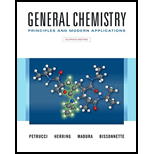
Interpretation:
The temperature calculated in example 13-12 using the van’t Hoff equation needs to be compared with the temperature calculated from the data in Appendix D and following equation:
And,
Concept introduction:
The Gibb’s equation of
With the help of this equation we can predict the change in
With the help of equation one can calculate the equilibrium constant at different temperature values.
Want to see the full answer?
Check out a sample textbook solution
Chapter 13 Solutions
Mastering Chemistry With Pearson Etext -- Standalone Access Card -- For General Chemistry: Principles And Modern Applications (11th Edition)
- Use the Gibbs-Helmholtz equation to demonstrate that C(diamond) is unstable with respect to C(graphite) at any temperature. See exercise 4.17 for H and G data.arrow_forward5.14. Determine and for the following reaction at , using data in Appendix 2. The partial pressures of the product and reactants are given in the chemical equation.arrow_forwardFor the reaction C(graphite)C(diamond) at 25C, H=+1.897kJ and G=2.90kJ. What is S for the reaction? From what you know about the structures of graphite and diamond, does the value of S make sense?arrow_forward
- Consider the following hypothetical equation A(s)+B(s)C(s)+D(s)where H =492kJ and S =327J/K. (a) Obtain an expression for G as a function of temperature. Prepare a table of G values at 100 K intervals between 100 K and 500 K. (b) Find the temperature at which G becomes zero.arrow_forwardList the sets of conditions that allow dS, dU, and dH of a process in a system act as a spontaneity condition.arrow_forwardUsing the thermodynamic information in the ALEKS Data tab, calculate the standard reaction entropy of the following chemical reaction: →+Al2O3s3H2g+2Als3H2Og Round your answer to zero decimal places. H2 0 , 0, 130arrow_forward
- (a) Under what conditions is a dA < 0 condition thatdefines the spontaneity of a process?(b) A sample containing 2.50 moles of He (1 bar, 350. K) ismixed with 1.75 mol of Ne (1 bar, 350. K) and 1.50 mol ofAr (1 bar, 350. K). Calculate AGmixing and ASmixing.arrow_forward1. Calculate the ΔGf for the amino acid glycine at 339 K if the standard ΔGf = -378 kJ/mol and the standard ΔHf = -537 kJ/mol at 298 K. Assume ΔHf is constant over the temperature range. Ans. in 0 decimal placesarrow_forwardTrouton’s rule states that for many liquids at their normalboiling points, the standard molar entropy of vaporizationis about 88 J/mol-K. (a) Estimate the normal boiling pointof bromine, Br2, by determining ΔH°vap for Br2. Assume that ΔH°vap remains constantwith temperature and that Trouton’s rule holds. (b) Look upthe normal boiling point of Br2 in a chemistry handbook orat the WebElements website (www.webelements.com) andcompare it to your calculation. What are the possible sourcesof error, or incorrect assumptions, in the calculation?arrow_forward
- In the thermodynamic definition of a spontaneous process, why is it important that the phrase “continuous intervention” be used rather than just “intervention?”arrow_forwardConsider the system shown in Figure 16.9. What is the change in entropy for the process where the energy is initially associated only with particle A, but in the final state the energy is distributed between two different particles?arrow_forwardPlots of Cp/T versus T are used to determine the entropy of a material, as the entropy value would be the area under the curve. For sodium sulfate, Na2SO4, the following data are available: T(K) Cp(cal/K) 13.74 0.171 16.25 0.286 20.43 0.626 27.73 1.615 41.11 4.346 52.72 7.032 68.15 10.48 82.96 13.28 95.71 15.33 Source: G.N. Lewis and M.Rabdall, Thermodynamics, rev. K. Pitzer and L.Brewer, McGraw-Hill, New York, 1961. Extrapolate to 0K using a function f(T)=kT3, where k is some constant. Using your plot, numerically evaluate the experimental entropy of Na2SO4 at 90K.arrow_forward
 Principles of Modern ChemistryChemistryISBN:9781305079113Author:David W. Oxtoby, H. Pat Gillis, Laurie J. ButlerPublisher:Cengage Learning
Principles of Modern ChemistryChemistryISBN:9781305079113Author:David W. Oxtoby, H. Pat Gillis, Laurie J. ButlerPublisher:Cengage Learning Physical ChemistryChemistryISBN:9781133958437Author:Ball, David W. (david Warren), BAER, TomasPublisher:Wadsworth Cengage Learning,
Physical ChemistryChemistryISBN:9781133958437Author:Ball, David W. (david Warren), BAER, TomasPublisher:Wadsworth Cengage Learning, Chemistry: Principles and ReactionsChemistryISBN:9781305079373Author:William L. Masterton, Cecile N. HurleyPublisher:Cengage Learning
Chemistry: Principles and ReactionsChemistryISBN:9781305079373Author:William L. Masterton, Cecile N. HurleyPublisher:Cengage Learning Chemistry by OpenStax (2015-05-04)ChemistryISBN:9781938168390Author:Klaus Theopold, Richard H Langley, Paul Flowers, William R. Robinson, Mark BlaserPublisher:OpenStax
Chemistry by OpenStax (2015-05-04)ChemistryISBN:9781938168390Author:Klaus Theopold, Richard H Langley, Paul Flowers, William R. Robinson, Mark BlaserPublisher:OpenStax Chemistry: Principles and PracticeChemistryISBN:9780534420123Author:Daniel L. Reger, Scott R. Goode, David W. Ball, Edward MercerPublisher:Cengage Learning
Chemistry: Principles and PracticeChemistryISBN:9780534420123Author:Daniel L. Reger, Scott R. Goode, David W. Ball, Edward MercerPublisher:Cengage Learning Chemistry for Engineering StudentsChemistryISBN:9781337398909Author:Lawrence S. Brown, Tom HolmePublisher:Cengage Learning
Chemistry for Engineering StudentsChemistryISBN:9781337398909Author:Lawrence S. Brown, Tom HolmePublisher:Cengage Learning





